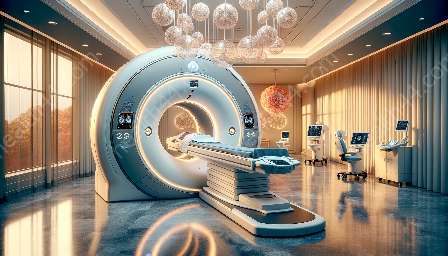Digital imaging systems play a vital role in the field of medical technology, revolutionizing the way medical professionals diagnose and treat patients. In this comprehensive topic cluster, we will delve into the world of digital imaging systems, exploring their compatibility with medical imaging devices and medical devices & equipment, and how they are transforming the healthcare industry.
Digital Imaging Systems in the Healthcare Industry
Advancements in digital imaging systems have significantly impacted the healthcare industry, providing healthcare professionals with powerful tools for accurate diagnosis, treatment planning, and monitoring of patients' conditions. These systems encompass a wide range of technologies, including X-ray imaging, computed tomography (CT), magnetic resonance imaging (MRI), ultrasound, and more.
Key Components of Digital Imaging Systems
Before delving into the compatibility of digital imaging systems with medical imaging devices and equipment, it's essential to understand the key components of these systems. Digital imaging systems consist of hardware, software, and imaging sensors that work together to capture, process, store, and display medical images.
- Hardware: This includes imaging devices such as X-ray machines, CT scanners, MRI machines, and ultrasound equipment. These devices capture the images of the patient's body or specific areas of interest.
- Software: The software component of digital imaging systems encompasses imaging processing software, picture archiving and communication systems (PACS), and advanced visualization software. These programs enable the manipulation, enhancement, and storage of medical images, as well as their integration with patient records.
- Imaging Sensors: These sensors capture the analog signals generated by the imaging devices and convert them into digital images, providing high-resolution and detailed representations of the patient's anatomy.
Compatibility with Medical Imaging Devices
Digital imaging systems are designed to be compatible with a wide array of medical imaging devices, ensuring seamless integration and interoperability within healthcare facilities. This compatibility allows for the sharing and retrieval of medical images and patient data across different imaging modalities and clinical departments.
Integration with Medical Imaging Devices
One of the key advantages of digital imaging systems is their ability to integrate with various medical imaging devices, such as X-ray units, CT scanners, and MRI machines. Through standardized protocols and interfaces, these systems can acquire images from different devices, enabling radiologists, clinicians, and other healthcare professionals to access and interpret the images efficiently.
Interoperability Across Modalities
In addition to compatibility with specific imaging devices, digital imaging systems promote interoperability across different imaging modalities. This means that medical images obtained from X-ray, CT, MRI, ultrasound, and other devices can be seamlessly accessed, viewed, and compared within a unified digital platform, facilitating comprehensive diagnostic evaluations and treatment planning.
Advancements in Medical Devices & Equipment
As digital imaging systems continue to evolve, they are driving advancements in medical devices and equipment, enhancing their capabilities and improving patient care. By integrating with state-of-the-art medical devices, these imaging systems contribute to the development of innovative diagnostic and therapeutic solutions.
Enhanced Imaging Capabilities
Medical devices and equipment that incorporate digital imaging systems benefit from enhanced imaging capabilities, such as improved image resolution, 3D reconstruction, and real-time imaging. For example, modern ultrasound machines equipped with advanced digital imaging technology can provide detailed and dynamic visualization of internal structures, allowing for precise diagnosis and guided interventions.
Diagnostic and Interventional Advancements
The integration of digital imaging systems with medical devices has led to significant advancements in diagnostic and interventional procedures. For instance, image-guided interventions, such as minimally invasive surgeries and targeted treatments, rely on the seamless interaction between imaging systems and specialized medical devices, enabling precise navigation and delivery of therapies.
The Future of Digital Imaging in Healthcare
Looking ahead, the future of digital imaging in healthcare holds immense potential for further innovation and transformation. As digital imaging systems continue to advance, they will play a pivotal role in personalized medicine, precision therapeutics, and the development of AI-driven diagnostic tools.
AI-Powered Imaging Analysis
The integration of artificial intelligence (AI) with digital imaging systems is expected to revolutionize the interpretation and analysis of medical images. AI algorithms, trained on vast datasets, can assist radiologists and clinicians in detecting abnormalities, quantifying disease markers, and predicting patient outcomes with unprecedented speed and accuracy.
Telemedicine and Remote Imaging
With the increasing adoption of telemedicine, digital imaging systems will facilitate remote imaging consultations and virtual patient assessments. Patients in remote or underserved areas can benefit from access to expert diagnoses and medical imaging interpretations through secure networking and telecommunication technologies.
Interdisciplinary Collaboration and Data Sharing
Digital imaging systems will continue to promote interdisciplinary collaboration and data sharing among healthcare professionals. By enabling the seamless exchange of medical images and reports, these systems support team-based approaches to patient care, fostering better communication and coordination across medical specialties.
Conclusion
In conclusion, digital imaging systems are fundamental components of modern medical technology, driving advancements in medical imaging devices, equipment, and the overall delivery of healthcare services. Their compatibility with a diverse range of imaging modalities, along with their potential for future innovation, underscores their indispensable role in shaping the future of healthcare. As technology continues to evolve, digital imaging systems will remain at the forefront of medical advancements, empowering healthcare professionals to provide precise diagnoses and personalized treatments while improving patient outcomes.


